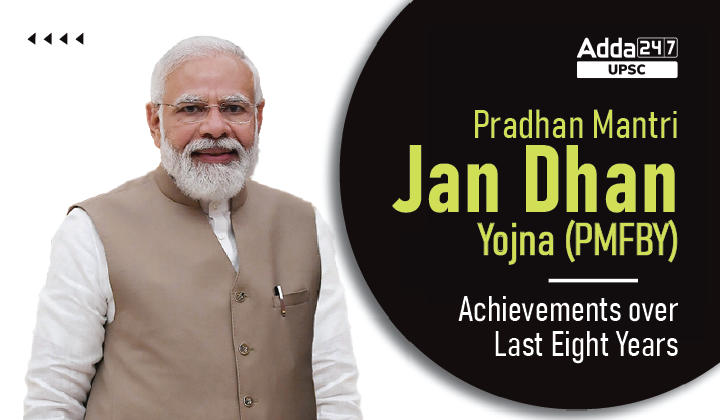Table of Contents
Pradhan Mantri Jan Dhan Yojana (PMJDY)- Relevance for UPSC Exam
- GS Paper 2: Governance, Administration and Challenges
- Government policies and interventions for development in various sectors and issues arising out of their design and implementation.
Pradhan Mantri Jan Dhan Yojana (PMJDY) in News
- Recently, Pradhan Mantri Jan Dhan Yojana (PMJDY) – National Mission for Financial Inclusion, completed eight years of successful implementation.
Pradhan Mantri Jan Dhan Yojana (PMJDY) Performance
PMJDY Accounts
- As on 10th August ’22 number of total PMJDY Accounts:25 crore; 55.59% (25.71 crore) Jan-Dhan account holders are women and 66.79% (30.89 crore) Jan Dhan accounts are in rural and semi-urban areas
- During first year of scheme 17.90 crore PMJDY accounts were opened
- Continuous increase in no of accounts under PMJDY: PMJDY Accounts have grown three-fold from 14.72 crore in Mar’15 to 46.25 crore as on 10-08-2022.
Operative PMJDY Accounts
- As per extant RBI guidelines, a PMJDY account is treated as inoperative if there are no customer induced transactions in the account for over a period of two years
- In August’22, out of total 46.25 crore PMJDY accounts, 37.57 crore (81.2%) are operative
- Only 8.2% PMJDY accounts are zero balance accounts
Deposits under PMJDY accounts
- Total deposit balances under PMJDY Accounts stand at Rs. 1,73,954 crore
- Deposits have increased about 7.60 times with increase in accounts 2.58 times
Average Deposit per PMJDY Account
- Average deposit per account is Rs. 3,761
- Deposit per account has increased over 2.9 times over Aug’15
Rupay Card issued to PMJDY account holders
- Total RuPay cards issued to PMJDY accountholders: 31.94 crore
- Number of RuPay cards & their usage has increased over time
About PMJDY
- Pradhan Mantri Jan Dhan Yojana (PMJDY) is National Mission for Financial Inclusion (Read about Financial Inclusion Index from here) to ensure access to financial services, namely, Banking/ Savings & Deposit Accounts, Remittance, Credit, Insurance, Pension in an affordable manner.
PM Jan Dhan Yojana (PMJDY) Objectives
- To ensure access of financial products & services at an affordable cost.
- To lower cost & widen reach in the country through use of technology.
Pradhan Mantri Jan Dhan Yojana benefits
- Banking the unbanked – Opening of basic savings bank deposit (BSBD) account with minimal paperwork, relaxed KYC, e-KYC, account opening in camp mode, zero balance & zero charges
- Securing the unsecured – Issuance of Indigenous Debit cards for cash withdrawals & payments at merchant locations, with free accident insurance coverage of Rs. 2 lakhs.
- Funding the unfunded – Other financial products like micro-insurance, overdraft for consumption, micro-pension & micro-credit.
PM Jan Dhan Yojana (PMJDY) Pillars
The PM Jan Dhan Yojana (PMJDY) scheme was launched based upon the following 6 pillars:
- Universal access to banking services through Branch and Banking Correspondents (BC).
- Basic savings bank accounts with overdraft facility of Rs. 10,000/- to every eligible adult
- Financial Literacy Program– Promoting savings, use of ATMs, getting ready for credit, availing insurance and pensions, using basic mobile phones for banking
- Creation of Credit Guarantee Fund – To provide banks some guarantee against defaults
- Insurance – Accident cover-up to Rs. 1,00,000 and life cover of 30,000 on account opened between 15 Aug 2014 to 31 January 2015.
- Pension scheme for Unorganized sector.
Extension of PM Jan Dhan Yojana (PMJDY) with new features
- The Government decided to extend the comprehensive PMJDY program beyond 28.8.2018 with some modifications
- Focus shifted from ‘Every Household’ to Every Unbanked Adult’
- RuPay Card Insurance – Free accidental insurance cover on RuPay cards increased from Rs. 1 lakh to Rs. 2 lakhs for PMJDY accounts opened after 28.8.2018.
- Enhancement in overdraft (OD) facilities –
- OD limit doubled from Rs 5,000/- to Rs 10,000/
- OD upto Rs 2,000/- (without conditions).
- Increase in upper age limit for OD from 60 to 65 years.



 TSPSC Group 1 Question Paper 2024, Downl...
TSPSC Group 1 Question Paper 2024, Downl...
 TSPSC Group 1 Answer key 2024 Out, Downl...
TSPSC Group 1 Answer key 2024 Out, Downl...
 UPSC Prelims 2024 Question Paper, Downlo...
UPSC Prelims 2024 Question Paper, Downlo...
